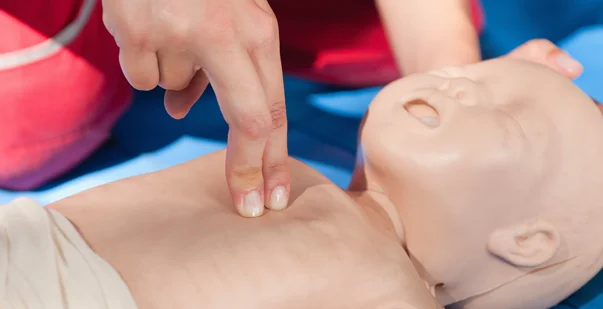Table Of Content(s)
- Child CPR: How to perform CPR on a child
- What are the 5 steps for giving CPR to an infant?
- Recognizing the Signs of Cardiac Arrest in Children
- What are the common mistakes to avoid when performing CPR on a child?
- Conclusion
When a child encounters an emergency, every second counts. Knowing how to perform cardiopulmonary resuscitation or CPR on a child can make all the difference in several emergencies. Being a critical skill, child/infant CPR is crucial for parents, caregivers, babysitters or anyone working closely with children. Children are more prone to accidents. Annually, 15,000 children in the US come across emergencies that need immediate CPR intervention.
Cardiopulmonary resuscitation helps maintain blood flow to vital organs till professional medical help arrives. Therefore understanding the basics of CPR and how it can make a profound impact on the lives of children in need stands crucial. In this blog, we will walk you through the steps of performing CPR (cardiopulmonary resuscitation) on a child. We will also be giving away information on how and when to start CPR on a kid, based on the context and background of the emergency. So let’s begin!
What are the 5 steps for giving CPR to an infant?
When an infant stops breathing or their heart ceases to beat, immediate action is critical. Performing CPR can help maintain oxygen flow to vital organs until professional medical help arrives. Here are the five essential steps to giving CPR to an infant:
- Assess the Situation: Quickly check for responsiveness and breathing. Gently tap the infant and shout their name to see if they react.
- Call for Help: If the infant is unresponsive and not breathing, call emergency services immediately. If you’re alone, perform CPR for two minutes before making the call.
- Open the Airway: Place the infant on their back and gently tilt their head back to open the airway. Be cautious and avoid overextending the neck.
- Give Rescue Breaths: Cover the infant’s nose and mouth with your mouth, creating a seal. Give two gentle breaths, each lasting about one second, watching for the chest to rise.
- Perform Chest Compressions: Use two fingers to press down on the center of the chest, just below the nipple line. Compress the chest about 1.5 inches deep at a rate of 100-120 compressions per minute.
Read More: How can CPR certification boost your resume?
Recognizing the Signs of Cardiac Arrest in Children
Recognizing the early signs of cardiac arrest in children is crucial for initiating timely CPR and increasing the chances of survival. Cardiac arrest in children can occur suddenly and without warning. It can often be the result of underlying health issues or traumatic events. Being aware of the signs and symptoms can help you act quickly and effectively. Here are the key indicators to watch for:
- Unresponsiveness: The child does not respond to verbal commands or gentle tapping.
- Abnormal Breathing: Breathing is irregular, labored, or has completely stopped.
- No Pulse: The absence of a detectable pulse, especially at major pulse points like the carotid artery.
- Sudden Collapse: The child suddenly loses consciousness and collapses without warning.
- Blue or Pale Skin: The child’s skin may appear blue (cyanosis) or unusually pale, indicating a lack of oxygen.
- Seizures: Sudden onset of seizures or convulsions without a prior history of epilepsy.
- Chest Pain or Discomfort: Although rare in younger children, older children might express sudden chest pain or discomfort before collapsing.
What are the common mistakes to avoid when performing CPR on a child?
When performing CPR on a child, it’s crucial to avoid common mistakes that can impact the effectiveness of the intervention. Here are some key mistakes to steer clear of:
- Delaying CPR: Waiting too long to start CPR can significantly reduce the chances of survival. Immediate action is crucial.
- Incorrect Hand Placement: Improper placement of hands during chest compressions can lead to ineffective compressions. Always ensure proper hand placement on the sternum.
- Insufficient Compression Depth: Chest compressions that are too shallow may not adequately circulate blood. Compressions should be about 1/3 to 1/2 the depth of the child’s chest, approximately 1.5 inches deep.
- Incorrect Compression Rate: Compressions that are too slow or too fast can be ineffective. The recommended rate is 100-120 compressions per minute.
- Not Allowing the Chest to Fully Recoil: Allowing the chest to fully recoil between compressions ensures optimal blood flow. Avoid leaning on the chest during the relaxation phase.
- Inadequate Rescue Breaths: Not giving effective rescue breaths, such as not ensuring a good seal or not giving enough breath volume, can hinder oxygenation.
- Stopping CPR Prematurely: Stopping CPR before emergency medical services arrive or before signs of life return can reduce the child’s chances of survival.
- Not Calling for Help Early Enough: Delaying or forgetting to call emergency services immediately after recognizing the need for CPR delays advanced medical intervention.
- Panic or Lack of Confidence: Staying calm and confident is essential for effective CPR. Panic can lead to hesitation and errors.
Read More: CPR Compression Rate: The Importance of Maintaining the Correct Compression Rate during CPR
Conclusion
Learning how to perform CPR on a child is more than just a skill. It is a lifesaving capability that can make a profound difference in emergencies. By mastering the step by step process of infant CPR, you can effectively save a child from danger. From assessing the situation to delivering rescue breaths, each step ensures optimum blood flow and oxygenation to vital organs. Remember, a culture that promotes CPR awareness, births a generation where individuals are prepared and proactive.
